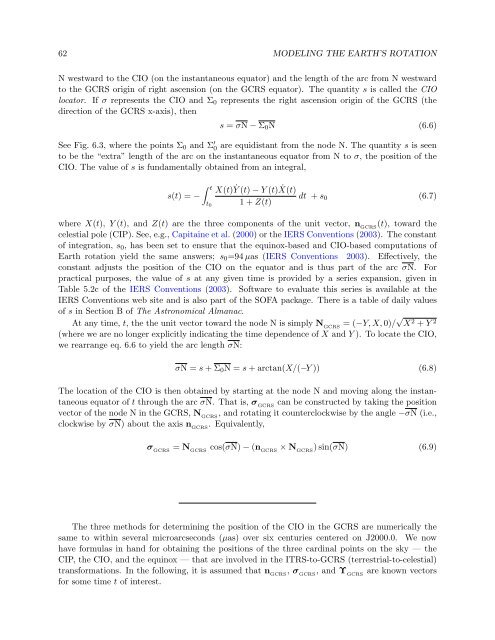USNO Circular 179 - U.S. Naval Observatory
USNO Circular 179 - U.S. Naval Observatory
USNO Circular 179 - U.S. Naval Observatory
Create successful ePaper yourself
Turn your PDF publications into a flip-book with our unique Google optimized e-Paper software.
62 MODELING THE EARTH’S ROTATION<br />
N westward to the CIO (on the instantaneous equator) and the length of the arc from N westward<br />
to the GCRS origin of right ascension (on the GCRS equator). The quantity s is called the CIO<br />
locator. If σ represents the CIO and Σ0 represents the right ascension origin of the GCRS (the<br />
direction of the GCRS x-axis), then<br />
s = σN − Σ0N (6.6)<br />
See Fig. 6.3, where the points Σ0 and Σ ′ 0 are equidistant from the node N. The quantity s is seen<br />
to be the “extra” length of the arc on the instantaneous equator from N to σ, the position of the<br />
CIO. The value of s is fundamentally obtained from an integral,<br />
t X(t)<br />
s(t) = −<br />
t0<br />
˙ Y (t) − Y (t) ˙ X(t)<br />
dt + s0<br />
1 + Z(t)<br />
where X(t), Y (t), and Z(t) are the three components of the unit vector, n GCRS (t), toward the<br />
celestial pole (CIP). See, e.g., Capitaine et al. (2000) or the IERS Conventions (2003). The constant<br />
of integration, s0, has been set to ensure that the equinox-based and CIO-based computations of<br />
Earth rotation yield the same answers; s0=94 µas (IERS Conventions 2003). Effectively, the<br />
constant adjusts the position of the CIO on the equator and is thus part of the arc σN. For<br />
practical purposes, the value of s at any given time is provided by a series expansion, given in<br />
Table 5.2c of the IERS Conventions (2003). Software to evaluate this series is available at the<br />
IERS Conventions web site and is also part of the SOFA package. There is a table of daily values<br />
of s in Section B of The Astronomical Almanac.<br />
At any time, t, the the unit vector toward the node N is simply N GCRS = (−Y, X, 0)/ √ X 2 + Y 2<br />
(where we are no longer explicitly indicating the time dependence of X and Y ). To locate the CIO,<br />
we rearrange eq. 6.6 to yield the arc length σN:<br />
(6.7)<br />
σN = s + Σ0N = s + arctan(X/(−Y )) (6.8)<br />
The location of the CIO is then obtained by starting at the node N and moving along the instantaneous<br />
equator of t through the arc σN. That is, σ GCRS can be constructed by taking the position<br />
vector of the node N in the GCRS, N GCRS , and rotating it counterclockwise by the angle −σN (i.e.,<br />
clockwise by σN) about the axis n GCRS . Equivalently,<br />
σ GCRS = N GCRS cos(σN) − (n GCRS × N GCRS ) sin(σN) (6.9)<br />
The three methods for determining the position of the CIO in the GCRS are numerically the<br />
same to within several microarcseconds (µas) over six centuries centered on J2000.0. We now<br />
have formulas in hand for obtaining the positions of the three cardinal points on the sky — the<br />
CIP, the CIO, and the equinox — that are involved in the ITRS-to-GCRS (terrestrial-to-celestial)<br />
transformations. In the following, it is assumed that n GCRS , σ GCRS , and Υ GCRS are known vectors<br />
for some time t of interest.


